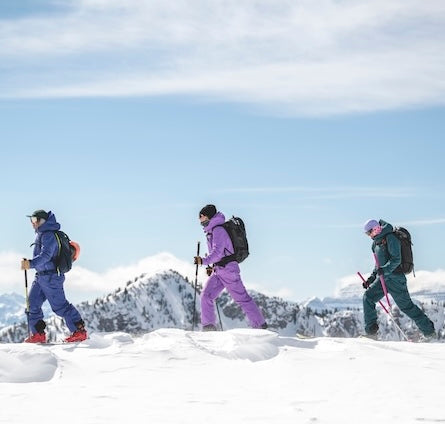
How to Pack Your Bike for Air Travel
Written by Wild Rye Pro Team Member Nicole Jorgenson
With spring break vibes coming on strong and domestic and international travel back to a "new normal," many of us are eager to go ride our bikes in new and faraway places. It can be a daunting task to break down your bike and pack it into a bag, crossing your fingers that it will come out okay on the other side, so we wanted to break it down, step by step. We've also included a helpful video to show you IRL.
With the right tips and tricks, it’s actually pretty simple and you’ll get speedy at it with a bit of practice. In this step-by-step description and video, we use a Dakine bike bag, but the process will be almost exactly the same (with the exception of the details of how everything fits in the bag) for other bags, such as the very popular EVOC bag. Read on and watch the video to learn how to disassemble your bike for your next two-wheeled adventure!
Before you get started, here's a list of equipment you’ll need:
- Bike + Bike Bag
- Multi-tool or set of allen wrenches (to remove pedals and misc. bolts)
- Extra packing materials (foam for padding, tape etc.)
- Zip ties
Step 1: Wash it!
Make sure your bike is clean before packing it, especially for an international trip. This not only makes for a much more pleasant experience when disassembling (and reassembling when you get there), it also prevents unnecessary wear on the paint, is better for your components and will keep the inside of your bike bag in good condition for many trips to come. Not to mention, some countries will not allow a dirty bike through customs!
Step 2: Look up your airline’s bike policy
This is going to affect what you can or cannot pack in your bike bag and will help you avoid an unpleasant surprise when it comes time to check your bag if you weren’t aware of the (often high) fees. Each airline has different rules regarding bike-specific checked bag fees and weight limits so be sure to check before you take off!
Step 3: Take your pedals off
Use either a pedal wrench, or more commonly, a 6mm or 8mm allen wrench. Remember, if your bike is on a stand or right side up, you will always be pulling towards the back of the bike to loosen your pedals and to the front of the bike to tighten them (yes, on both sides!!). If you are working with your bike turned upside down, then do the opposite.
Step 4: Take your handlebars off
Step one is to loosen your stem screws, but make sure not to lose them. Then, unscrew the stem bolt (located on your top cap right behind the middle of your bars). Take your stem, with the bars attached, all the way off of your steer tube and replace any spacers and your stem bolt so that it doesn’t get lost. If you have any spacers above or below your stem, make sure to remember their orientation (pro tip: take a picture) so that when you rebuild your bike, it will fit and feel the same as before. Your bag should have a pad made specifically to secure your bars to your frame vertically. If not, use packing supplies and zip ties to secure it to your frame.
Step 5: Remove your derailleur
First, shift down to your smallest cog (this will help later when reassembling your bike). Unscrew your derailleur at the derailleur bolt, leaving your derailleur hanger on your frame. This is very important, as it’s best to avoid the threads that screw your derailleur hanger onto your frame. Most bike bags will come with a derailleur bag that you can tuck your derailleur into. If not, use some packing materials and tape to wrap it up.
Removing and protecting your derailleur is one of the most important steps to disassembling your bike. This will ensure that your shifting is just how you left it when you go to rebuild your bike at your destination, and although your bike will likely fit in its bag with the derailleur attached, that increases your chances of bending your hanger or damaging your derailleur.
Step 6: Take your wheels off
Remove your wheels and replace your thru axles. Replacing your thru axles helps protect the integrity of your frame during transport and also reduces the likelihood of forgetting them. It is preferable to remove your rotors as well, as there is a high chance of them getting bent during transport. However, this is a personal choice!
Remember: once you take your wheels off, make sure not to grab your brakes to prevent air from getting into your brake lines. You can also use brake pad spacers to prevent this.
Step 7: Place your frame into your bag and secure it
Each bag or case will have different mechanisms to secure the frame into itself. For the Dakine bike bag, there are color-coordinated straps that hold the frame in place. Once your frame is cozy in its bag, carefully tuck your derailleur into the frame so that it’s not as vulnerable. Be careful not to put too much strain on your derailleur cable. Tuck the wheels in around the frame – in most bags they’ll have a designated spot.
Step 8: Take some air out of your tires
You’ll want to take a bit of air out since pressure will increase during the flight. Make sure not to take so much out that you break your tubeless seal.
Step 9: Weigh it!
Here is where you need to know your airline’s specific rules. Most checked bags and bike bags have an allowance of 50 lbs and often don’t allow any wiggle room. Depending on your bike’s weight, you may need to put your pedals and any tools in another bag. If your bike is on the lighter side, make sure you pack your pedals in something protective so that they won’t move around and scratch your frame during transport. You may even be able to throw your helmet or shoes in!
Step 10: Don’t forget your tools and extra parts!
Make sure you have everything necessary to rebuild your bike and fix any quick repairs while on your trip. At minimum you’ll want a set of allen wrenches (make sure you have one big enough for your pedals!), a pump, a flat repair kit (although keep in mind that you can’t take CO2 cartridges on the plane), an extra set of brake pads, a spare derailleur hanger, lube and a rag. If your destination is more remote, you may want to throw a few more replacement parts in!
Traveling with your bike opens up so many possibilities! Maybe you’re going on a bike-focused adventure, or maybe you just want to be able to explore local trails while on a work trip. The bike bags and cases that exist today make packing your bike so easy, and with a little practice, you’ll have it dialed. Feel free to reach out to me on instagram @the.alpen.impulse if you run into any questions while getting your bike ready to travel!



![[Saffron] Danner 3/4 Zip saffron yellow flatlay](http://wild-rye.com/cdn/shop/files/DANNER_SAFFRON.jpg?v=1764970727&width=2160)
![[Saffron] Danner 3/4 Zip Saffron yellow front crop view](http://wild-rye.com/cdn/shop/files/WILDRYE4908.jpg?v=1764970727&width=2048)
![[Amethyst] Heyburn 3L Jacket in amethyst, flatlay](http://wild-rye.com/cdn/shop/files/WildRye_HeyburnJacket_Amethyst_1.jpg?v=1759164917&width=2048)
![[Amethyst] Heyburn 3L Jacket in amethyst, on model front crop view](http://wild-rye.com/cdn/shop/files/WILDRYE6636.jpg?v=1759165998&width=2048)
![[Shaded Spruce] Heyburn 3l bibs in shaded spruce, flatlay](http://wild-rye.com/cdn/shop/files/WildRye_HeyburnBib_Spruce_1.jpg?v=1759173988&width=2048)
![[Shaded Spruce] Heyburn 3l bibs in shaded spruce, on model front full body view](http://wild-rye.com/cdn/shop/files/WILDRYE6166.jpg?v=1759173988&width=2048)
![[Olive You] Freyah Pant Olive flatlay](http://wild-rye.com/cdn/shop/files/FREYA_OLIVEYOU.jpg?v=1757356787&width=2160)
![[Olive You] Freyah Pant Olive front full body view](http://wild-rye.com/cdn/shop/files/WILDRYE3613.jpg?v=1757436391&width=1815)
![[Storm Contour] Bassett Half zip in storm purple with light purple floral pattern, flatlay](http://wild-rye.com/cdn/shop/files/BassettHalfZip_StormContour.jpg?v=1757965879&width=2160)
![[Storm Contour] Bassett Half zip in storm contour, on model front crop view](http://wild-rye.com/cdn/shop/files/WILDRYE4159.jpg?v=1757965879&width=2048)
![[Chestnut Storm] Brown baselayer legging with purple colorblocked stripe on each leg, flatlay](http://wild-rye.com/cdn/shop/files/BassettLegging_Chestnut.jpg?v=1757963384&width=2160)
![[Chestnut Storm] chestnut storm blocked baselayer legging, on model front crop view](http://wild-rye.com/cdn/shop/files/WILDRYE4041.jpg?v=1757963384&width=2048)
![[Shaded Spruce] Payette insulated pullover in shaded spruce, flatlay](http://wild-rye.com/cdn/shop/files/WildRye_PayettePullover_Spruce_1.jpg?v=1758837674&width=2048)
![[Shaded Spruce] Payette insulated pullover in shaded spruce, on model front crop view](http://wild-rye.com/cdn/shop/files/WILDRYE5759.jpg?v=1758838275&width=2048)
![[Iris] Payete Insulated Pant in Iris purple with floral contrast stitching, flatlay](http://wild-rye.com/cdn/shop/files/WildRye_PayettePant_Iris.jpg?v=1758840409&width=2048)
![[Iris] Payette Insulated Pant in Iris purple, on model front crop view](http://wild-rye.com/cdn/shop/files/WILDRYE5496.jpg?v=1758840409&width=2048)





Leave a comment
This site is protected by hCaptcha and the hCaptcha Privacy Policy and Terms of Service apply.